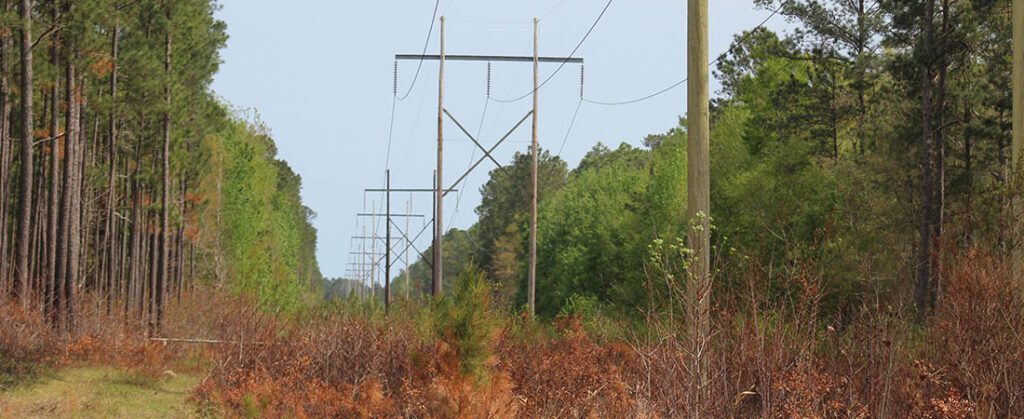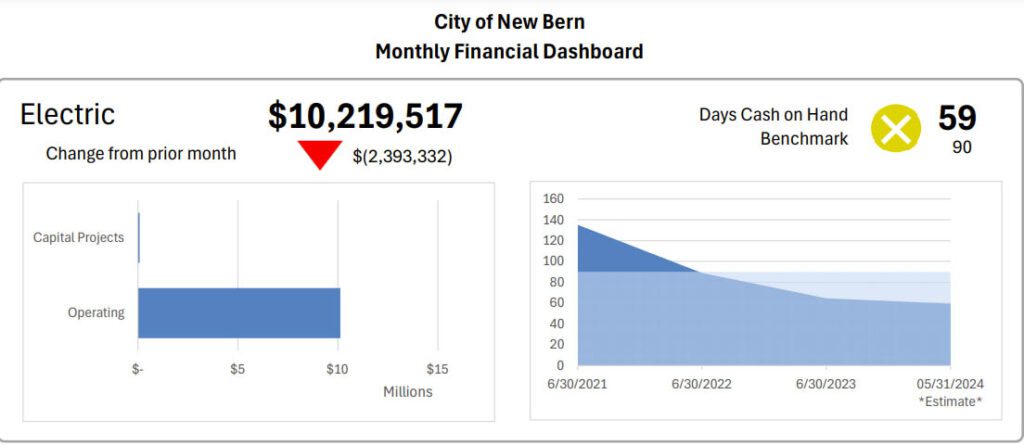
New Bern’s electric utility asks for a rate increase and adjustment riders to support cash requirements and invest in an aging infrastructure.
The City of New Bern Department of Public Utilities is asking the Board of Aldermen for a 5% increase in the electric rate for three years, a $0.0033 power cost adjustment rider and a $0.0061 revenue reconciliation adjustment rider after a financial study identifies cash flow problems. If approved, the changes would be effective on July 1, 2024. An alternative proposal is an 18% rate increase in July and a 4% rate increase in 2026. A public hearing is set for tomorrow at City Hall.
Charles Bauschard, director of public utilities, presented a forecast of the utility’s financial health to the Board of Aldermen during a work session meeting on May 22, 2024 at Pleasant Hill Recreation Center in New Bern, NC.
The board was expecting this report as Charles Bauschard told them about potential rate adjustments and other issues in December 2023. He said the North Carolina Eastern Municipal Power agency voted to approve a rider and another was coming.
New Bern is one of 32 members that make up NCEMPA. Electricities staff manages contracts for NCEMPA because the agency doesn’t have any employees. The majority of the power supply is bought through NCEMPA from Duke Energy Progress.
He told the board that he was trying to find ways to provide essential electric service that’s affordable, safe, reliable, and resilient while protecting the “investment in the electric utility” and ensuring the utility is financially healthy.
He said he hired Dawn and Chris Lund of Utility Financial Solutions, LLC, to conduct an electric utility financial study and “develop a three-year rate plan that supported revenue requirements.”
Bauschard identified revenue requirements as power supply costs, sales, cash balance, general fund and debt service.
He said power supply costs, debt service and contributions to the general fund are increasing while the cash balance is declining, and sales remain flat.
“Sales vary with weather, so they are up when temperatures are hot and temperatures are cold,” Bauschard said.
He also said labor and benefits, inflation, utility locates, NCDOT utility relocates, safety and training and education costs are also increasing.
“How do we respond to severe weather events? We might roll out a grade A hurricane plan and get everybody back on quick or we could make a decision not to do that…we could not spend money on that same thing with outages and outage detection isolating our outages,” Bauschard said.
He said, “Take a two o’clock in the morning outage. We don’t have to call a guy in. We don’t have to spend those overtime dollars. We can wait until morning until staff gets here and then we can respond to it.”
He noted variable components to the revenue requirements are severe weather events, outages, metering, billing, customer service and customer engagement.
He said the infrastructure was 40 years old and parts of the distribution system is 50 years old and is beyond its useful life.
“Given the right condition and you take one of my contingencies away, we’re out of power for a while. We just came really close to that this winter. I lost one of three transformers…I got it back about two weeks ago. It’s 50 years old,” Bauschard said.
He applied for a grant through the Department of Energy Grid Resilience and Innovation Partnership Program.
Bauschard has been expressing the need for a new substation on County Line Road to the Board of Aldermen for years. In 2019, the cost was $10 million. It’s now 20 million.
He also said the line extension policy is under collecting. He said the board decided on a three-year line extension policy after receiving pressure from developers.
Bauschard said the utility gets “a little bit of money up front.”
He continued, “We’re spending hundreds of thousands of dollars and aren’t recovering the money until seven to ten years later. After the house is sold and someone plugs something in the wall” until they recover money, Bauschard said.
He also said the cost of utility locates have quadrupled with the increase in broadband providers in the area.
He said NCDOT projects are drawing down cash as they have to relocate city owned utilities.
Dawn Lund, vice president of Utility Financial Solutions, LLC, presented the findings of the financial study.
She said the utility’s cash is declining, power supply costs are increasing and the infrastructure is aging.
She said the last two city audits showed the utility was operating at a loss and highlighted areas that “really jumped out” at her.
Employees was one of them. She expressed the need to be competitive with wages. “It’s getting harder and harder to retain, replace and attract talented workers in the electric utility,” Lund said.
NewBernNow.com compared the FY21-22 and FY 24-25 budgets and it appears eight positions were added since 2021. The 2020 actual salaries and benefits totaled about $6 million, the 2024 salaries and benefits were about $7 million as of May 2024 and the board approved a budget for 8.9 million for 2025.
It would take “at least an 18% rate increase followed by some inflationary type increases” to break even, Lund said.
Lund said an enterprise fund “it’s run almost like a business. It provides a service, and it should be recouping and covering the revenues from that enterprise fund. It should be recouping its own expenses, its capital and its debt payments. So, we need to make sure we’re keeping it healthy to keep providing those services.”
She reviewed the utility’s rates over the last nine years and said the Board of Aldermen lowered rates by approximately 18% in 2015, 2016 and 2017 after “Electricities lowered the wholesale power cost because some debt was paid off on their side.”
“The reason you’re faced with larger increases today is, keep in mind you haven’t had a rate increase or rate change in over nine years while costs have increased greatly,” Lund said.
She said inflation has increased about 21% since 2018 and “your costs during the same period for the electric budget has increased almost 20%.”
Lund said the “current cash reserve policy is about $15 million.” She recommended that the utility maintain a minimum cash balance of $19 million.
The cash balance was estimated at $10.2 million, according to the city’s monthly report for May. See image 1.

She said transfer of funds from the utility to the city have increased by about 17%.
Lund said the infrastructure is “about 39% of the net book value” and considered it to be an aging system.
“I would expect your capital improvement program to be much more aggressive.”
“If we don’t keep investing in our system’s aging infrastructure, it affects reliability and the need for a rate increase.”
The problem “doesn’t go away because you pushed it down the road, it only compounds,” Lund said.
Dawn Lund said they projected $20 million in GRIP grant funds into the projected plan, but they aren’t guaranteed to receive it.
Chris Lund, financial, business and technology consultant, said a “power cost adjustment tracks power supply costs and if power usually are eight cents a kilowatt hour and now they go up to 8.5 cents, I better recoup that additional half cent so the piece of the PCA becomes that half cent. So basically, it’s a fuel adder.”
Alderman Rick Prill said, “We have an aging infrastructure of our electric utility and we’re behind the eight ball. Before it runs itself into the ground, we have to become more aggressive in updating our infrastructure.”
The New Bern Board of Aldermen will conduct a public hearing before they vote on the rate increase and adjustments during the June 25 meeting at City Hall located at 300 Pollock Street. See the meeting agenda and packet here.
Watch meetings on City 3 TV here.
The proposed rates are shown in the below table. It is an example of the rates based on a residential customer using 997 kWh per month.
See the full list of rates on the city’s website here.

Watch the presentation of the financial study here:
By Wendy Card, editor. Send an email with questions or comments.

